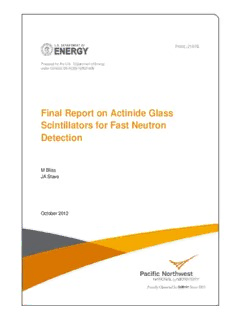
Final Report on Actinide Glass Scintillators for Fast Neutron Detection PDF
Preview Final Report on Actinide Glass Scintillators for Fast Neutron Detection
PNNL-21976 Prepared for the U.S. Department of Energy under Contract DE-AC05-76RL01830 Final Report on Actinide Glass Scintillators for Fast Neutron Detection M Bliss JA Stave October 2012 PNNL-21976 Final Report on Actinide Glass Scintillators for Fast Neutron Detection M Bliss JA Stave October 2012 Prepared for the U.S. Department of Energy under Contract DE-AC05-76RL01830 Pacific Northwest National Laboratory Richland, Washington 99352 PNNL-21976 Summary This is the final report of an experimental investigation of actinide glass scintillators for fast-neutron detection. It covers work performed during FY2012. This supplements a previous report, PNNL-20854 “Initial Characterization of Thorium-loaded Glasses for Fast Neutron Detection” (October 2011). The work in FY2012 was done with funding remaining from FY2011. As noted in PNNL-20854, the glasses tested prior to July 2011 were erroneously identified as scintillators. The decision was then made to start from “scratch” with a literature survey and some test melts with a non-radioactive glass composition that could later be fabricated with select actinides, most likely thorium. The normal stand-in for thorium in radioactive waste glasses is cerium in the same oxidation state. Since cerium in the 3+ state is used as the light emitter in many scintillating glasses, the next most common substitute was used: hafnium. Three hafnium glasses were melted. Two melts were colored amber and a third was clear. It barely scintillated when exposed to alpha particles. The uses and applications for a scintillating fast neutron detector are important enough that the search for such a material should not be totally abandoned. This current effort focused on actinides that have very high neutron capture energy releases but low neutron capture cross sections. This results in very long counting times and poor signal to noise when working with sealed sources. These materials are best for high flux applications and access to neutron generators or reactors would enable better test scenarios. The total energy of the neutron capture reaction is not the only factor to focus on in isotope selection. Many neutron capture reactions result in energetic gamma rays that require large volumes or high densities to detect. If the scintillator is to separate neutrons from gamma rays, the capture reactions should produce heavy particles and few gamma rays. This would improve the detection of a signal for fast neutron capture. iii PNNL-21976 Acronyms and Abbreviations DOE U.S. Department of Energy HPGe High-purity germanium detector MCNP Monte Carlo N-Particle Transport Code NA-22 Office of Nonproliferation and Verification Research and Development NNSA National Nuclear Security Administration PMT Photomultiplier Tube PNNL Pacific Northwest National Laboratory v PNNL-21976 Contents 1.0 Introduction .......................................................................................................................... 10 2.0 FY2012 Efforts ..................................................................................................................... 11 2.1 Commercial Uranium Glass Phoswich .................................................................................. 11 2.2 Non-radioactive analogue glass ............................................................................................. 12 3.0 Discussion and Conclusion .................................................................................................. 15 4.0 References ............................................................................................................................. 16 vii PNNL-21976 Figures Figure 1: Commercial uranium glass compared to enriched lithium glass. The blue curve is the thermal neutron response of enriched lithium glass alone, exposed to moderated 252Cf. The other curves represent responses captured with the uranium glass mounted on the enriched lithium glass. The uranium glass reduced the thermal neutron response of the enriched lithium glass. ............................................................................................................................. 12 Figure 2: Ten-hour background and AmBe counting runs of the clear hafnium-loaded glass ....... 14 viii
Description: